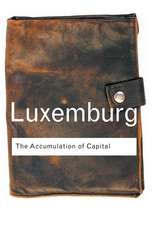Capital
Autor Karl Marx Editat de Friedrich Engels Traducere de Edward Aveling, Samuel Mooreen Limba Engleză Paperback – 17 sep 2003
| Toate formatele și edițiile | Preț | Express |
|---|---|---|
| Paperback (14) | 37.92 lei 3-5 săpt. | +27.11 lei 7-13 zile |
| Wordsworth Editions – 4 mai 2013 | 37.92 lei 3-5 săpt. | +27.11 lei 7-13 zile |
| Oxford University Press – 17 apr 2008 | 56.54 lei 11-16 zile | +24.73 lei 7-13 zile |
| CREATESPACE – | 66.20 lei 3-5 săpt. | |
| CREATESPACE – 30 iun 2010 | 74.73 lei 3-5 săpt. | |
| Dover Publications Inc. – 30 sep 2019 | 79.37 lei 3-5 săpt. | +22.42 lei 7-13 zile |
| Penguin Books – 27 mai 1992 | 91.62 lei 22-33 zile | +34.51 lei 7-13 zile |
| Penguin Books – 26 aug 1992 | 107.32 lei 22-33 zile | +46.76 lei 7-13 zile |
| Penguin Books – 5 dec 1990 | 108.20 lei 22-33 zile | +48.24 lei 7-13 zile |
| LAWRENCE & WISHART LTD – 17 sep 2003 | 162.26 lei 3-5 săpt. | +39.53 lei 7-13 zile |
| COSIMO CLASSICS – 31 dec 2012 | 154.97 lei 6-8 săpt. | |
| COSIMO CLASSICS – 31 dec 2012 | 155.52 lei 6-8 săpt. | |
| COSIMO CLASSICS – 31 dec 2012 | 204.06 lei 6-8 săpt. | |
| COSIMO CLASSICS – 31 dec 2012 | 207.68 lei 6-8 săpt. | |
| COSIMO CLASSICS – 31 dec 2012 | 219.64 lei 6-8 săpt. | |
| Hardback (5) | 225.90 lei 6-8 săpt. | |
| COSIMO CLASSICS – 31 dec 2012 | 225.90 lei 6-8 săpt. | |
| COSIMO CLASSICS – 31 dec 2012 | 226.49 lei 6-8 săpt. | |
| COSIMO CLASSICS – 31 dec 2012 | 309.76 lei 6-8 săpt. | |
| COSIMO CLASSICS – 31 dec 2012 | 319.23 lei 6-8 săpt. | |
| COSIMO CLASSICS – 31 dec 2012 | 438.70 lei 6-8 săpt. |
Preț: 162.26 lei
Nou
31.06€ • 32.02$ • 26.19£
Carte disponibilă
Livrare economică 06-20 februarie
Livrare express 23-29 ianuarie pentru 49.52 lei
Specificații
ISBN-10: 0853159793
Pagini: 768
Dimensiuni: 140 x 218 x 45 mm
Greutate: 0.96 kg
Editura: LAWRENCE & WISHART LTD
Descriere
A classic of early modernism, Capital combines vivid historical detail with economic analysis to produce a bitter denunciation of mid-Victorian capitalist society. It has also proved to be the most influential work in social science in the twentieth century; Marx did for social science what Darwin had done for biology. Millions of readers this century have treated Capital as a sacred text, subjecting it to as many different interpretations as the bible itself. No mere work of dry economics, Marx's great work depicts the unfolding of industrial capitalism as a tragic drama - with a message which has lost none of its relevance today. This is the only abridged edition to take account of the whole of Capital. It offers virtually all of Volume 1, which Marx himself published in 1867, excerpts from a new translation of `The Result of the Immediate Process of Production', and a selection of key chapters from Volume 3, which Engels published in 1895. ABOUT THE SERIES: For over 100 years Oxford World's Classics has made available the widest range of literature from around the globe. Each affordable volume reflects Oxford's commitment to scholarship, providing the most accurate text plus a wealth of other valuable features, including expert introductions by leading authorities, helpful notes to clarify the text, up-to-date bibliographies for further study, and much more.
Notă biografică
Cuprins
Translator's Preface
Preface to the First Edition
Postface to the Second Edition
Preface to the French Edition
Postface to the French Edition
Preface to the Third Edition (by Engels)
Preface to the English Edition (by Engels)
Preface to the Fourth Edition (by Engels)
BOOK I: THE PROCESS OF PRODUCTION OF CAPITAL
Part One: Commodities and Money
Chapter 1: The Commodity
1. The Two Factors of the Commodity: Use-Value and Value (Substance of VAlue, Magnitude of Value)
2. The Dual Character of the Labour Embodied in Commodities
3. The Value-Form, or Exchange-Value
(a) The Simple, Isolated, or Accidental Form of Value
(1) The two poles of the expression of value: the relative form of value and the equivalent form
(2) The relative form of value
(i) The content of the relative form of value
(ii) The quantitative determinacy of the relative form of value
(iii) The equivalent form
(iv) The simple form of value considered as a whole
(b) The Total or Expanded Form of Value
(1) The expanded relative form of value
(2) The particular equivalent form
(3) Defects of the total or expanded form of value
(c) The General Form of Value
(1) The changed character of the form of value
(2) The development of the relative and equivalent forms of value: their interdependence
(3) The transition from the general form of value to the money form
(d) The Money Form
4. The Fetishism of the Commodity and Its Secret
Chapter 2: The Process of Exchange
Chapter 3: Money, or the Circulation of Commodities
1. The Measure of Values
2. The Means of Circulation
(a) The Metamorphosis of Commodities
(b) The Circulation of Money
(c) Coin. The Symbol of Value
3. Money
(a) Hoarding
(b) Means of Payment
(c) World Money
PART TWO: THE TRANSFORMATION OF MONEY INTO CAPITAL
Chapter 4: The General Formula for Capital
Chapter 5: Contradictions in the General Formula
Chapter 6: The Sale and Purchase of Labour-Power
PART THREE: THE PRODUCTION OF ABSOLUTE SURPLUS-VALUE
Chapter 7: The Labour Process and the Valorization Process
1. The Labour Process
2. The Valorization Process
Chapter 8: Constant Capital and Variable Capital
Chapter 9: The Rate of Surplus-Value
1. The Degree of Exploitation of Labour-Power
2. The Representation of the Value of the Product by Corresponding Proportional Parts of the Product
3. Senior's "Last Hour"
4. The Surplus Product
Chapter 10: The Working Day
1. The Limits of the Working Day
2. The Voracious Appetite for Surplus Labour. Manufacturer and Boyar
3. Branches of English Industry without Legal Limits to Exploitation
4. Day Work and Night Work. The Shift System
5. The Struggle for a Normal Working Day. Laws for the Compulsory Extension of the Working Day, from the Middle of the Fourteenth to the End of the Seventeenth Century
6. The Struggle for a Normal Working Day. Laws for the Compulsory Limitation of Working Hours. The English Factory Legislation of 1833-64
7. The Struggle for a Normal Working Day. Impact of the English Factory Legislation on Other Countries
Chapter 11: The Rate and Mass of Surplus-Value
PART FOUR: THE PRODUCTION OF RELATIVE SURPLUS-VALUE
Chapter 12: The Concept of Relative Surplus-Value
Chapter 13: Co-operation
Chapter 14: The Division of Labour and Manufacture
1. The Dual Origin of Manufacture
2. The Specialized Worker and His Tools
3. The Two Fundamental Forms of Manufacture - Heterogeneous and Organic
4. The Division of Labour in Manufacture, and the Division of Labour in Society
5. The Capitalist Character of Manufacture
Chapter 15: Machinery and Large-Scale Industry
1. The Development of Machinery
2. The Value Transferred by the Machinery to the Product
3. The Most Immediate Effects of Machine Production on the Worker
(a) Appropriation of Supplementary Labour-Power by Capital. The Employment of Women and Children
(b) The Prolongation of the Working Day
(c) Intensification of Labour
4. The Factory
5. The Struggle between Worker and Machine
6. The Compensation Theory, with Regard to the Workers Displaced by Machinery
7. Repulsion and Attraction of Workers through the Development of Machine Production. Crises in the Cotton Industry
8. The Revolutionary Impact of Large-Scale Industry on Manufacture, Handicrafts and Domestic Industry
(a) Overthrow of Co-operation Based on Handicrafts and on the Division of Labour
(b) The Impact of the Factory System on Manufacture and Domestic Industries
(c) Modern Manufacture
(d) Modern Domestic Industry
(e) Transition from Modern Manufacture and Domestic Industry to Large-Scale Industry. The Hastening of this Revolution by the Application of the Factory Acts to those Industries
9. The Health and Education Clauses of the Factory Acts. The General Extension of Factory Legislation in England
10. Large-Scale Industry and Agriculture
PART FIVE: THE PRODUCTION OF ABSOLUTE AND RELATIVE SURPLUS-VALUE
Chapter 16: Absolute and Relative Surplus-Value
Chapter 17: Changes of Magnitude in the Price of Labour-Power and in Surplus-Value
1. The Length of the Working Day and the Intensity of Labour Constant; the Productivity of Labour Variable
2. The Length of the Working Day and the Productivity of Labour Constant; the Intensity of Labour Variable
3. The Productivity and Intensity of Labour Constant; the Length of the Working Day Variable
4. Simultaneous Variations in the Duration, Productivity and Intensity of Labour
Chapter 18: Different Formulae for the Rate of Surplus-Value
PART SIX: WAGES
Chapter 19: The Transformation of the Value (and Respectively the Price) of Labour-Power into Wages
Chapter 20: Time-Wages
Chapter 21: Piece-Wages
Chapter 22: National Differences in Wages
PART SEVEN: THE PROCESS OF ACCUMULATION OF CAPITAL
Chapter 23: Simple Reproduction
Chapter 24: The Transformation of Surplus-Value into Capital
1. Capitalist Production on a Progressively Increasing Scale. The Inversion which Converts the Property Laws of Commodity Production into Laws of Capitalist Appropriation
2. The Political Economists' Erroneous Conception of Reproduction on an Increasing Scale
3. Division of Surplus-Value into Capital and Revenue. The Abstinence Theory
4. The Circumstances which, Independently of the Proportional Division of Surplus-Value into Capital and Revenue, Determine the Extent of Accumulation, namely, the Degree of Exploitation of Labour-Power, the Productivity of Labour, the Growing Difference in Amount between Capital Employed and Capital Consumed, and the Magnitude of the Capital Advanced
5. The So-Called Labour Fund
Chapter 25: The General Law of Capitalist Accumulation
1. A Growing Demand for Labour-Power Accompanies Accumulation if the Composition of Capital Remains the Same
2. A Relative Diminution of the Variable Part of Capital Occurs in the Course of the Further Progress of Accumulation and of the Concentration Accompanying It
3. The Progressive Reduction of a Relative Surpluse Population or Industrial Reserve Army
4. Different Forms of Existence of the Relative Surplus Population. The General Law of Capitalist Accumulation
5. Illustrations of the General Law of Capitalist Accumulation
(a) England from 1846 to 1866
(b) The Badly Paid Strata of the British Industrial Working Class
(c) The Nomadic Population
(d) Effect of Crises on the Best Paid Section of the Working Class
(e) The British Agricultural Proletariat
(f) Ireland
PART EIGHT: SO-CALLED PRIMITIVE ACCUMULATION
Chapter 26: The Secret of Primitive Accumulation
Chapter 27: The Expropriation of the Agricultural Population from the Land
Chapter 28: Bloody Legislation against the Expropriated since the End of the Fifteenth Century. The Forcing Down of Wages by Act of Parliament
Chapter 29: The Genesis of the Capitalist Farmer
Chapter 30: Impact of the Agricultural Revolution on Industry. The Creation of a Home Market for Industrial Capital
Chapter 31: The Genesis of the Industrial Capitalist
Chapter 32: The Historical Tendency of Capitalist Accumulation
Chapter 33: The Modern Theory of Colonization
Appendix: Results of the Immediate Process of Production
Introduction by Ernest Mandel
I. Commodities as the Product of Capital
II. Capitalist Production as the Production of Surplus-Value
III. Capitalist Production is the Production and Reproduction of the Specifically Capitalist Relations of Production
IV. Isolated Fragments
Quotations in Languages Other than English and German
Index of Authorities Quoted
General Index
Note on Previous Editions of the Works of Marx and Engels
Chronology of Works by Marx and Engels
























